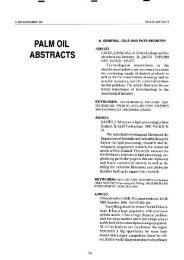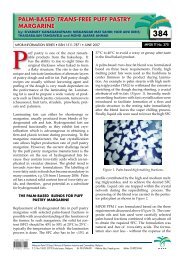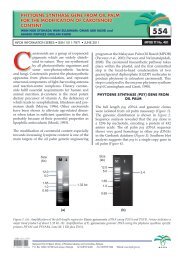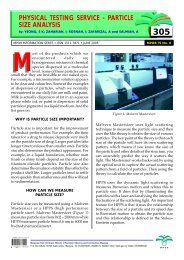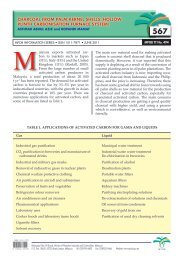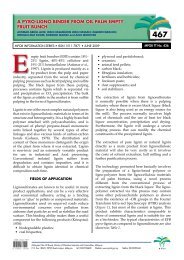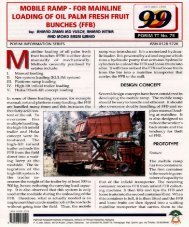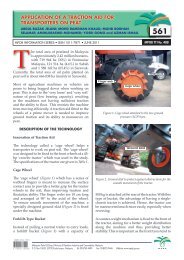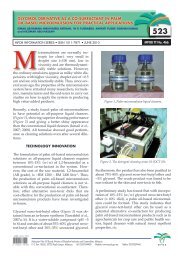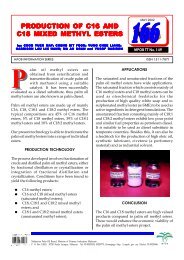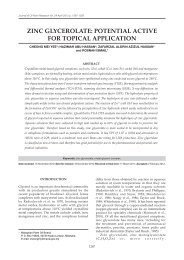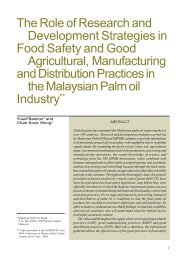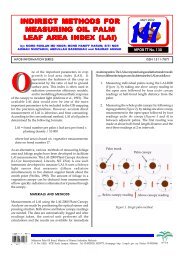SPECTROSCOPIC IDENTIFICATION OF GEOMETRICAL ISOMERS ...
SPECTROSCOPIC IDENTIFICATION OF GEOMETRICAL ISOMERS ...
SPECTROSCOPIC IDENTIFICATION OF GEOMETRICAL ISOMERS ...
You also want an ePaper? Increase the reach of your titles
YUMPU automatically turns print PDFs into web optimized ePapers that Google loves.
JOURNAL Journal of <strong>OF</strong> Oil OIL Palm PALM Research RESEARCH Vol. 17 (DECEMBER 17 December 2005) 2005, p. 92-102<br />
<strong>SPECTROSCOPIC</strong> <strong>IDENTIFICATION</strong> <strong>OF</strong><br />
<strong>GEOMETRICAL</strong> <strong>ISOMERS</strong> <strong>OF</strong> α- AND<br />
β-CAROTENES FROM PALM OIL<br />
* Malaysian Palm Oil Board,<br />
P. O. Box 10620,<br />
50720 Kuala Lumpur, Malaysia.<br />
E-mail: bonnie@mpob.gov.my<br />
** Universiti Putra Malaysia,<br />
Department of Chemistry,<br />
Faculty of Science and Environment,<br />
43400 UPM Serdang, Selangor, Malaysia.<br />
BONNIE TAY YEN PING* and GWENDOLINE EE CHENG LIAN**<br />
ABSTRACT<br />
To date, all identification of palm carotenoids are tentative based on electronic absorption spectra, comparison<br />
of the elution sequence with past studies and authentic standards. This study reports the isolation of individual<br />
major isomers of palm carotenes using a semi-preparative C column. The results of MS, 30 1H NMR of four<br />
isolated peaks, assigned as Fraction 1 (a mixture of 13 and 13’ cis α-carotene), Fraction 2 ( 13 cis β-carotene),<br />
Fraction 3 (all trans α-carotene) and Fraction 4 (cis β-carotene) supported the identification of their structures.<br />
Keywords: geometrical isomers, palm oil carotenes, 1 H NMR – MS, data of palm carotenoids.<br />
Date received: 28 February 2004; Sent for revision: 1 April 2004; Received in final form: 15 March 2005; Accepted: 24 November 2005.<br />
INTRODUCTION<br />
Crude palm oil is one of the richest natural sources<br />
of carotenoids. The carotenoid concentration varies<br />
from 400-3500 ppm depending on the species of oil<br />
palm. The crude oil from tenera, the commercial<br />
planting material, contains 500-700 ppm carotenes.<br />
The early identification of palm carotenoids used the<br />
C 18 column separation with HPLC with a photo<br />
diode array detector (DAD) (Ng and Tan, 1988) or<br />
UV-Vis detector (Yap et al., 1991). Their findings<br />
showed that palm carotenoids comprised 11 types<br />
of hydrocarbon carotenes and oxygenated ones<br />
referred to as xanthophylls. Identification of the<br />
palm carotenoids from these findings were based on<br />
retention time comparison with authentic standards<br />
and UV-Vis spectral identification. However,<br />
complete separation of the geometric isomers of αand<br />
β-carotene were not achieved. With the advent<br />
of the C 30 column, the geometric isomers of these<br />
major carotenes were resolved. Analyses of<br />
carotenoids in crude palm oil, red palm olein and<br />
carotene concentrates have shown the presence of<br />
13 cis, 13’ cis and 9 cis isomers of the major carotenes,<br />
α- and β-carotenes (Tay et al., 2002; Darnoko et al.,<br />
92<br />
2000; Puspitasari-Nienaber et al., 2002). However,<br />
again identification of these geometric isomers were<br />
based on comparison with the elution sequences<br />
from past studies and electronic absorption spectra.<br />
No standards of cis isomers were available for<br />
comparison. This study was aimed at isolating the<br />
individual geometric isomers of the major carotenes<br />
from a preparative reverse phase C 30 column and<br />
confirming their structures by 1 H NMR and MS.<br />
Materials<br />
MATERIALS AND METHODS<br />
A 30% palm-based carotene concentrate<br />
produced via the methyl esters route was obtained<br />
from a commercial source. Synthetic all trans βcarotene<br />
was obtained from Sigma Chemical Co. The<br />
HPLC solvents were methanol (certified ACS; Fisher<br />
Chemcial, Fairlawn, NJ, USA) and methyl-tert-butyl<br />
ether (MTBE) (HPLC grade; Fisher). Analytical grade<br />
acetone was obtained from Fisher Chemicals.<br />
Methods<br />
Instrumentation and chromatography. An analytical<br />
Develosil reverse phase (RP)-aqueous C 30 (4.6 mm<br />
i.d. x 250 mm, 5 mm) and semi-preparative C 30 (10<br />
mm i.d. x 250 mm, 5 mm) columns were used and<br />
protected with guard columns (4.6 mm i.d x 50 mm)<br />
and (10 mm i.d x 50 mm). The HPLC system<br />
comprised of a Hewlett Packard Model 1100 with
quarternary solvent delivery system and a HP1100<br />
series online degasser, and was connected to a<br />
HP1100 series diode array detector (DAD) covering<br />
the spectral range 190 –800 nm.<br />
Analytical carotenoid profile analyses. The<br />
carotenoid isomer chromatogram from the carotene<br />
concentrate was obtained at analytical scale using<br />
the isocratic mobile phase of MeOH:MTBE (89:11)<br />
v/v at a flow rate of 1 ml min -1 . About 0.3 g of the<br />
concentrates was dissolved in 2 ml acetone and 20<br />
ml were injected. The chromatogram was monitored<br />
at 444 nm with the column temperature at ambient<br />
laboratory (25ºC). The chromatogram is shown in<br />
Figure 1.<br />
Isolation of Palm Carotenes Isomers<br />
About 0.35 g of the 30% carotene concentrate was<br />
dissolved in 20 ml acetone. The mixture was injected<br />
into the HPLC-PDA attached to a semi-preparative<br />
C 30 column with a sample injector loop of 2 ml. The<br />
solvent system was 89:11 methanol:MTBE (v/v) and<br />
at a flow rate of 4.6 ml min -1 . The chromatogram<br />
showed four major fractions as shown in Figure 2.<br />
<strong>SPECTROSCOPIC</strong> <strong>IDENTIFICATION</strong> <strong>OF</strong> <strong>GEOMETRICAL</strong> <strong>ISOMERS</strong> <strong>OF</strong> α- AND β-CAROTENES FROM PALM OIL<br />
93<br />
These fractions were focused for isolation. In the<br />
case of Fractions 1 and 2, about 2-3 ml of the mobile<br />
phase were collected. For Fractions 3 and 4, 5-6 ml<br />
of the mobile phase were collected. The solvents were<br />
removed in vacuo at 35ºC for 30 min and the<br />
remaining solvent removed by nitrogen sparging. All<br />
the samples were kept under a head space of<br />
nitrogen at –30ºC prior to analysis. The collection of<br />
peaks was repeated till the pooled fractions of the<br />
isomers weighed 4-10 mg, sufficient for 1 H NMR<br />
and MS analyses.<br />
Mass spectrometric analyses of isolated fractions.<br />
The mass spectra of the four isolated fractions from<br />
preparative HPLC were obtained by direct insertion<br />
(DI) into a Shimadzu QP5050A, Mass Spectrometer<br />
using electron impact (EI) ionization and analysed<br />
using GC-MS solution software.<br />
1 H NMR spectroscopy. The 1 H NMR spectra were<br />
obtained on a JEOL JMM ECA-400 Mhz NMR<br />
spectrometer. All the spectra were measured in<br />
CDCl 3 at ≈ 25ºC. The internal standard was<br />
tetramethylsilane.<br />
Figure 1. HPLC profile at 444 nm of the carotene concentrate using an analytical column with reverse phase C 30<br />
stationary phase, MTBE-methanol (11:89, v/v) mobile phase; at a flow rate of 1 ml min -1 . 1a) 13 cis α-carotene 1b) 13’<br />
cis α-carotene 2) 13 cis β-carotene 3) cis α-carotene 4) all trans α-carotene 5) 9 cis α-carotene 6) all trans βcarotene<br />
and 7) 9 cis β-carotene.
JOURNAL <strong>OF</strong> OIL PALM RESEARCH 17 (DECEMBER 2005)<br />
Figure 2. HPLC profile at 444 nm of the carotene concentrate using a semi-preparative column with RP C 30<br />
stationary phase, MTBE-methanol (11:89,v/v) mobile phase; flow rate of 4.6 ml min -1 . (a) Fraction 1 (b) Fraction 2<br />
(c) Fraction 3 and (d) Fraction 4.<br />
RESULTS AND DISCUSSION<br />
The four major fractions between 40-100 min in<br />
Figure 2 were collected individually and repeatedly<br />
until about 4 mg for Fractions 1 and 2 and 5-10 mg<br />
for Fractions 3 and 4. Peak purity checks were<br />
performed on the four fractions using HP<br />
Chemstation and it was found that the fractions<br />
contained some impurities which could be (1) an<br />
94<br />
overlapping carotene isomer, and/or (2) traces of<br />
esters or grease. Based on the electronic absorption<br />
spectra (Table 1) and the apparent split in peak 1<br />
(Figure 1), it was deduced to contain mono cis<br />
geometric isomers of α-carotene, in which the cis<br />
bonds are present at carbons 13 and 13’, i.e. at<br />
opposite ends of the molecule. Peak 2 was assigned<br />
as 13 cis β-carotene, peak 3 (Table 1) as all trans αcarotene<br />
and peak 6 (Table 1) as all trans β-carotene.<br />
TABLE 1. ELECTRONIC ABSORPTION MAXIMA <strong>OF</strong> PEAKS FROM Figure 1<br />
Peak Absorption maxima (nm)<br />
This study Previous studies b<br />
1a (13 cis α-carotene) 332 410 (440) a 463 331 nd (438) 466<br />
1b (13’ cis α-carotene) 331 410 (440) 464 331 nd (438) 465<br />
2 (13 cis β-carotene) 338 421 (444) 470 (443)<br />
4 (trans α-carotene) 423 (445) 476 nd (445) 474<br />
6 (trans β-carotene) 422 (452) 478 (450)<br />
Notes:<br />
a Values in parentheses represent the main absorption maxima.<br />
b Absorption maxima for α-carotene isomers in MTBE (Emenhiser et al., 1996) and main absorption maxima<br />
for β-carotene isomers (Emenhiser et al., 1995).<br />
nd - no maxima detected.
As further confirmation of the assignment of<br />
peaks 1-4, the MS spectra were obtained and are<br />
shown in Figures 3a to d. The intensities of the<br />
characteristics peaks in the MS spectra of Fractions 1<br />
to 4 from Figure 3 is shown in Table 2. All the four<br />
peaks gave the strong (M+1) fragment peak<br />
indicating the same molecular formula (C 40 H 56 ) and<br />
<strong>SPECTROSCOPIC</strong> <strong>IDENTIFICATION</strong> <strong>OF</strong> <strong>GEOMETRICAL</strong> <strong>ISOMERS</strong> <strong>OF</strong> α- AND β-CAROTENES FROM PALM OIL<br />
95<br />
provided almost similar fragmentation patterns.<br />
However, the intensities of the characteristics peaks<br />
for Fractions 1, 4 for α-carotene and 3, 4 for β-carotene<br />
differed, enabling them to be distinguished from<br />
each other. Also, the MS spectra of peaks 1 and 3,<br />
showed that the two characteristics peaks due to<br />
losses of 56 and 123 mass units from the precursor<br />
Figure 3. Mass spectra of (a) Fraction 1 (b) Fraction 2 (c) Fraction 3 and (d) Fraction 4.<br />
(M+1)<br />
(M+1)<br />
(M+1)<br />
(M+1)
JOURNAL <strong>OF</strong> OIL PALM RESEARCH 17 (DECEMBER 2005)<br />
ion attributed to the unconjugated 4,5 double bond<br />
in the terminal ring (alpha ionone ring) of alpha<br />
carotene [M – 56] + at m/z 481 resulting from retro-<br />
Diels Alder (RDA) fragmentation of the α-ionone<br />
ring, and [M-123] + at m/z 413 due to loss of the ring<br />
at the doubly allylic position. A combination of<br />
elimination of toluene and retro-Diels Alder<br />
fragmentation ([M-92-56] + ) at m/z 388 was<br />
detectable, but not in the β-carotene MS spectrum.<br />
For Fractions 2 and 4, an abundant fragment ion was<br />
observed at 444, from the apparent elimination of<br />
methyl toluene. No specific fragmentation due to the<br />
end groups was observed as shown in Figures 3b and<br />
d. The base peak for the cis form of α- and β-carotenes<br />
was at (M+1) 537 and m/z 105. The base peaks for<br />
the trans form of α- and β-carotenes were at (M+1)537<br />
and m/z 55, respectively. There were some impurities<br />
in the four fractions as indicated by the peaks at m/z<br />
552 (Fractions 1 and 3) corresponding to β-carotene<br />
5,6 epoxide and at m/z 553 (Fractions 2 and 4).<br />
Table 3 shows the 1 H signals for the α-carotene<br />
isomers, Fractions 1 and 3, obtained on 400 MHz<br />
NMR. The chemical shifts (δ in ppm) of Fractions 1<br />
and 3 were compared with those reported by<br />
Emenhiser et al. (1996) from a pure mixture of<br />
standard α-carotene.<br />
Figures 4 and 6 show the 1 H NMR spectra for<br />
Fractions 1 and 3. Fraction 1 was confirmed to be a<br />
mixture of two isomers, 13 cis and 13’cis. The<br />
chemical shifts at H-2, H-3, H-4, H-16 to H-20 for<br />
Fraction 1 correlated well with the published data<br />
for 13 cis and 13’cis α-carotenes. In Fraction 1, the<br />
downfield isomerization shift of ∆δ = 0.52 observed<br />
at H-12 (6.89), H-15 (6.79) and upfield at H-14 (6.10)<br />
supported the presence of the 13 cis form. At the same<br />
spectral, downfield signals at H-12’(6.86), H-10’<br />
(6.17), H- 15 (6.55) and upfield at H-14 (6.24) are<br />
characteristic of a 13’ cis form. Peaks at C15’ were<br />
not detected.<br />
TABLE 2. INTENSITIES <strong>OF</strong> CHARACTERISTIC PEAKS IN THE MASS SPECTRA <strong>OF</strong> FRACTIONS 1 – 4, SYNTHETIC ALL<br />
trans β<br />
β-CAROTENE, β<br />
AND FROM PUBLISHED DATA FOR β ββ-<br />
β AND α-CAROTENE*<br />
Carotene Relative intensity at m/z<br />
43 59 69 73 83 91 109 133 (M+1)<br />
β-Carotene* 30 0 100 0 23 45 22 34 44<br />
Synthetic all trans β-carotene 15 0 100 0 20 43 25 33.6 70<br />
Peak 2 nm 0 80 14 50 87 40 44 75<br />
Peak 4 nm 0 73 13 30 32 25 32 83<br />
α-Carotene* 38 0 92 2 20 94 29 35 100<br />
Peak 1 nm 0 98 16 18 84 32 41 98<br />
Peak 3 nm 0 84 4 11 27 16 30 87<br />
Notes: nm - not measured; M + = molecular ion.<br />
* from Vetter et al. (1971).<br />
96<br />
The chemical shifts of Fraction 3 data showed<br />
good correlation with published data for all trans αcarotene.<br />
However, not all the signals were assigned,<br />
i.e. methylene protons, C-H eq (2’) and olefinic<br />
protons C-H (7,10’, 11 and 15’). The 1 H NMR spectra<br />
(Figure 6) showed impurities in Fraction 3 at δ 0.06,<br />
δ 0.80, δ 0.79, δ 1.25. ~ δ 3.6, δ 4.72, δ 5.11 and δ 5.4<br />
ppm. However, these impurities did not obscure the<br />
characteristic peaks for structure assignment.<br />
Table 4 shows the 1 H signals for β-carotene<br />
isomers, Fraction 2, synthetic all trans β-carotene and<br />
published data for trans β-carotene. The chemicals<br />
shift of Fraction 4, assigned as trans β-carotene<br />
correlated well with those of synthetic all trans<br />
β-carotene and published data.<br />
Fraction 2 was previously tentatively assigned as<br />
the 13 cis form of β-carotene and reconfirmed by MS<br />
to be β-carotene. Assignment of the peaks at H-12,12’<br />
at 6.98 and H-14,14’ at 6.117 was based on the<br />
isomerization shifts ∆δ = δ cis - δ trans (in ppm) of<br />
different protons based on the average ∆δ values by<br />
Englert, (1982) at H-12 of 0.62 and H-14 of 0.12 for<br />
the 13 cis isomer. The methylene protons, H-7, H-8,<br />
H-10, H-11, and all the methyl protons correlated<br />
well with published data (Vetter et al., 1971) and<br />
synthetic all trans β-carotene. This supported the<br />
presence of 13 cis β-carotene in this fraction. In the<br />
1 H NMR spectra (Figure 5), there was some oncolumn<br />
reisomerization in Fraction 2, as evidenced<br />
by the olefinic protons of the trans form at δ 6.24, δ<br />
6.33 and δ 6.64.<br />
Impurities were detected at the chemical shifts<br />
between δ 3.0 and δ 5.0 ppm for peaks 2 and 4.<br />
However, these impurities did not have any major<br />
impact on the main characteristic proton shifts<br />
essential for identification.
<strong>SPECTROSCOPIC</strong> <strong>IDENTIFICATION</strong> <strong>OF</strong> <strong>GEOMETRICAL</strong> <strong>ISOMERS</strong> <strong>OF</strong> α- AND β-CAROTENES FROM PALM OIL<br />
TABLE 3. 1 H NMR DATA FOR FRACTIONS 1 AND 3<br />
Position and type Fraction 1 Fraction 3<br />
of proton 13 cis 13’ cis cis trans α-carotene<br />
2 methylene 1.47 (≈ 1.47) nd (≈ 1.47) 1.47 (≈ 1.47)<br />
2’ methylene nd (≈ 1.47 ax) nd (≈ 1.47 ax) nd (≈ 1.47 ax)<br />
nd (≈ 1.20 eq) nd (≈ 1.19 eq) nd (≈ 1.18 eq)<br />
3 methylene 1.67 (≈ 1.62 ) nd (≈ 1.61 ) 1.59 (≈ 1.61)<br />
3’ methylene 2.03 (≈ 2.02 ) nd (≈ 2.02 ) 2.02 (≈ 2.02)<br />
4 methylene 2.03 (≈ 2.03 ) nd (≈ 2.02 ) 2.02 (≈ 2.03 )<br />
4’ olefinic 5.41 (5.41) nd (5.42) 5.40 (5.41)<br />
6’ methine nd (2.18) nd (2.20) 2.19 (2.18)<br />
7 olefinic - (6.19) 6.17 (6.17) 6.14 (6.17)<br />
7’ olefinic 5.51 (5.52) 5.55 (5.55) 5.53 (5.53)<br />
8 olefinic 6.15 (6.15) - (6.13) 6.14 (6.14)<br />
8’ olefinic 6.11 (6.11) - (6.12) 6.11 (6.11)<br />
10 olefinic - (6.19) 6.15 (6.15) 6.15 (6.15)<br />
10’ olefinic - (6.13) 6.17 (6.17) nd (6.13)<br />
11 olefinic - (6.65) 6.64 (6.64) 6.64 (6.65)<br />
11’olefinic - (6.60) 6.61 (6.62) 6.61 (6.61)<br />
12 olefinic 6.89 (6.88) 6.36 (6.36) 6.36 (6.35)<br />
12’ olefinic 6.33 (6.34) 6.86 (6.87) 6.33 (6.34)<br />
14 olefinic 6.10 (6.10) 6.24 (6.23) 6.25 (≈ 6.25)<br />
14’ olefinic 6.24 (6.23) 6.10 (6.10) -<br />
15 olefinic 6.78 (6.79) 6.55 (6.55) 6.25 (≈ 6.25)<br />
15’ olefinic nd (≈- 0.07) nd (≈0.17) nd (6.55)<br />
16 & 17 methyl 1.03 (1.03) - (1.031) 1.02 (1.029)<br />
16’ methyl 0.90 (0.904) - (0.911) 0.90 (0.904)<br />
17’ methyl 0.82 (0.822) - (0.828) 0.82 (0.822)<br />
18 methyl 1.72 (1.726) - (1.719) 1.71 (1.718)<br />
18’ methyl 1.59 (1.585) - (1.592) 1.58 (1.584)<br />
19 methyl 1.97 (1.977) - (1.970) 1.97 (1.972)<br />
19’ methyl 1.91 (1.909) - (1.917) 1.91 (1.911)<br />
20 methyl 1.99 (1.972) - (1.963) 1.97 (1.972)<br />
20 methyl 1.95 (1.952) - (1.981) 1.96 (1.962)<br />
Notes: nd - not detected.<br />
(-) = peaks overlapped for 13 cis and 13’ cis.<br />
Published results are in brackets.<br />
Source: Emenhiser et al. (1996).<br />
97
JOURNAL <strong>OF</strong> OIL PALM RESEARCH 17 (DECEMBER 2005)<br />
Figure 4. 1 H NMR spectra of Fraction 1.<br />
98
<strong>SPECTROSCOPIC</strong> <strong>IDENTIFICATION</strong> <strong>OF</strong> <strong>GEOMETRICAL</strong> <strong>ISOMERS</strong> <strong>OF</strong> α- AND β-CAROTENES FROM PALM OIL<br />
Figure 5. 1 H NMR spectra of Fraction 2.<br />
99
JOURNAL <strong>OF</strong> OIL PALM RESEARCH 17 (DECEMBER 2005)<br />
Figure 6. 1 H NMR spectra of Fraction 3.<br />
100
<strong>SPECTROSCOPIC</strong> <strong>IDENTIFICATION</strong> <strong>OF</strong> <strong>GEOMETRICAL</strong> <strong>ISOMERS</strong> <strong>OF</strong> α- AND β-CAROTENES FROM PALM OIL<br />
TABLE 4. 1 H NMR DATA FOR FRACTION 2, FRACTION 4 AND SYNTHETIC ALL trans β-CAROTENE<br />
Position and type Fraction 2 Fraction 4 Synthetic all trans<br />
of proton 13 cis β-carotene all trans β-carotene β-carotene<br />
2 2’ methylene 1.48 1.48 1.48 (1.45)<br />
3 3’methylene 1.60 1.60 1.60 (≈1.60)<br />
4 4’ methylene 2.02 2.02 2.01 (2.02)<br />
7 7’ olefinic 6.14 6.14 6.14 (≈6.14)<br />
8 8’olefinic 6.14 6.14 6.14 (≈6.14)<br />
10 10’ olefinic 6.14 6.14 6.14 (6.145)<br />
11 11’ olefinic 6.64 6.64 6.64 (6.65)<br />
12 12’ olefinic 6.98 6.33 6.33 (6.34)<br />
14 14’ olefinic 6.11 6.24 6.24 (≈6.24)<br />
15 15’olefinic NA 6.63 6.62 (≈6.63)<br />
1 1’ methyl 1.03 1.02 1.02 (1.03)<br />
5 5’methyl 1.72 1.72 1.71 (1.72)<br />
9 9’ methyl 1.97 1.97 1.97 (1.98)<br />
13 13’ methyl 1.97 1.97 1.97 (1.98)<br />
Notes: NA – not assigned.<br />
Published data are in column 4 in brackets.<br />
Source: Vetter et al. (1971).<br />
CONCLUSION<br />
Previous identifications of palm carotenoids were<br />
based on electronic absorption spectra obtained from<br />
analysis in a HPLC-PDA with a C 30 column. By<br />
collecting the fractions individually and analysing<br />
them with 1 H NMR and MS the combined<br />
spectroscopic data supported the identification of the<br />
major palm carotenes. These data are the first ever<br />
published results for the major palm carotenoids.<br />
This information is important because of the<br />
increasing use of palm carotenoids as health<br />
supplements.<br />
ACKNOWLEDGEMENT<br />
The authors would like to thank the Director-General<br />
of MPOB for permission to publish this paper.<br />
REFERENCES<br />
DARNOKO, D; CHERYAN, M; MOROS; JERREL, J<br />
and PERKINS, E G (2000). Simultaneous HPLC<br />
analysis of palm carotenoids and tocopherols using<br />
a C 30 column and photodiode array detector. J. Liq.<br />
Chrom. & Rel.Technol., 23(12): 1873-1885.<br />
EMENHISER, C; ENGLERT, G; SANDER, L C;<br />
LUDWIG, B and SCHWARTZ, S J (1996). Isolation<br />
and structural elucidation of the predominant<br />
101<br />
geometrical isomers of α-carotene. J. Chrom. A., 719:<br />
333-343.<br />
EMENHISER, C; SANDER, L C and SCHWARTZ, S<br />
J (1995). Capability of a polymeric C30 stationery<br />
phase to resolve cis-trans carotenoids isomers in<br />
reversed-phase liquid chromatography. J. Chrom. A.,<br />
707: 205-216.<br />
ENGLERT, G (1982). NMR of Carotenoids. Carotenoid<br />
Chemistry and Biochemistry (Britton, G and Goodwin,<br />
T W eds.). Pergammon, Oxford. 221 pp.<br />
NG, J H and TAN, B (1998). Analysis of palm oil<br />
carotenoids by HPLC with diode array detection. J.<br />
Chromato. Sc., 26: 463-469.<br />
PUSPITASARI-NIENABER, N L; FERRUZZI, M G<br />
and SCHWARTZ, S J (2002). Simulataneous detection<br />
of tocopherols, carotenoids and clorophylls in<br />
vegetable oils by direct injection C 30 RP-HPLC with<br />
coulometric electrochemical array detection. J. Amer.<br />
Oil Chem. Soc., 79:633-640.<br />
TAY, Y P; CHOO, Y M; EEE, G C L and GOH, S H<br />
(2002). Geometrical isomers of the major pro-vitamin<br />
A palm carotenes, α- and β-carotenes in the mesocarp<br />
oil of fresh and sterilized palm fruits, crude palm oil<br />
and palm carotene based products: red palm olein<br />
and carotene concentrates. J. Oil Palm Research Vol.<br />
13 No. 2: 23-32.
JOURNAL <strong>OF</strong> OIL PALM RESEARCH 17 (DECEMBER 2005)<br />
VETTER, W; ENGLERT, G; RIGASSI, N and<br />
SCHWIETER, U (1971a). Spectroscopic Methods in<br />
Carotenoids (Isler, O ed.). Chapter IV. Birkhauser<br />
Verlag Basel UND, Stuttgart. p. 258-259.<br />
VETTER, W; ENGLERT, G; RIGASSI, N and<br />
SCHWIETER, U (1971b). Spectroscopic Methods in<br />
102<br />
Carotenoids (Isler, O. ed.). Chapter IV. Birkhauser<br />
Verlag Basel UND, Stuttgart. p. 236-237.<br />
YAP, S C; CHOO, Y M; OOI, C K; ONG, A S H and<br />
GOH, S H (1991). Quantitative analysis of carotenes<br />
in the oil from different palm species. Elaeis 3(2):<br />
369-378.



